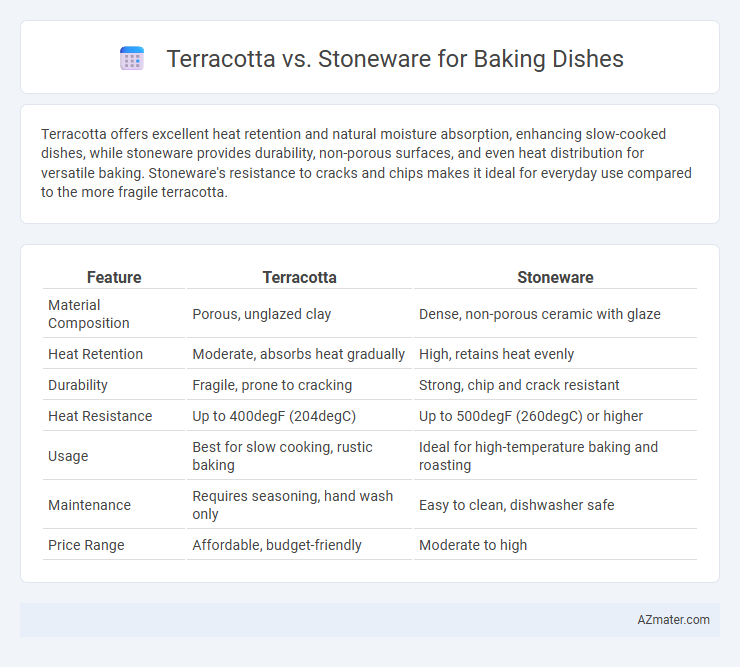Terracotta offers excellent heat retention and natural moisture absorption, enhancing slow-cooked dishes, while stoneware provides durability, non-porous surfaces, and even heat distribution for versatile baking. Stoneware's resistance to cracks and chips makes it ideal for everyday use compared to the more fragile terracotta.
Table of Comparison
| Feature | Terracotta | Stoneware |
|---|---|---|
| Material Composition | Porous, unglazed clay | Dense, non-porous ceramic with glaze |
| Heat Retention | Moderate, absorbs heat gradually | High, retains heat evenly |
| Durability | Fragile, prone to cracking | Strong, chip and crack resistant |
| Heat Resistance | Up to 400degF (204degC) | Up to 500degF (260degC) or higher |
| Usage | Best for slow cooking, rustic baking | Ideal for high-temperature baking and roasting |
| Maintenance | Requires seasoning, hand wash only | Easy to clean, dishwasher safe |
| Price Range | Affordable, budget-friendly | Moderate to high |
Introduction to Baking Dishes: Terracotta vs Stoneware
Terracotta and stoneware are popular materials for baking dishes, each offering distinct thermal properties and aesthetic qualities. Terracotta is porous and heats evenly, providing a rustic look and natural flavor enhancement, while stoneware is dense, non-porous, and offers superior heat retention and durability. Choosing between terracotta and stoneware depends on cooking style, temperature requirements, and desired presentation.
What is Terracotta? Key Features and Benefits
Terracotta is a porous, natural clay material fired at low temperatures, known for its excellent heat retention and even cooking properties, making it ideal for baking dishes. Its key features include breathability that allows moisture to evaporate, preventing sogginess, and a rustic aesthetic favored in traditional and artisanal cooking. Benefits of terracotta baking dishes encompass enhanced flavor development, natural non-stick qualities over time, and durability when properly seasoned and cared for.
What is Stoneware? Key Features and Benefits
Stoneware is a dense, non-porous ceramic material fired at high temperatures between 1,100degC and 1,300degC, making it highly durable and resistant to chipping and cracking. Its excellent heat retention and even heat distribution create optimal baking conditions for dishes like casseroles, breads, and roasted vegetables. Stoneware's non-porous surface resists stains and odors, allowing for easy cleaning and long-term use without retaining flavors from previous meals.
Heat Retention and Distribution Comparison
Terracotta baking dishes excel in heat retention due to their porous nature, allowing gradual heat absorption and even cooking, though they may require longer preheating. Stoneware offers superior heat distribution with a dense, non-porous composition that ensures consistent temperature and reduces hot spots, ideal for baking delicate dishes. Both materials provide effective heat management, but terracotta's slow heat release suits slow-cooked recipes, while stoneware's uniform heat spread benefits quick, high-temperature baking.
Durability and Longevity: Which Lasts Longer?
Stoneware offers superior durability and longevity compared to terracotta, as it is fired at higher temperatures, creating a denser and more chip-resistant material. Terracotta is more porous and prone to cracking or chipping over time, especially with frequent temperature changes or rough handling. For long-term use and resistance to wear, stoneware baking dishes are the better choice due to their strength and ability to withstand regular oven use without degradation.
Cooking Performance: Flavor and Texture Results
Terracotta baking dishes provide excellent heat retention and even cooking, enhancing the natural moisture of baked goods and producing tender, flavorful results with a rustic texture. Stoneware offers superior heat distribution and durability, creating consistent browning and a slightly crisp crust while maintaining soft interiors. Both materials improve cooking performance but terracotta excels in moisture preservation, whereas stoneware is better for achieving firm textures and uniform heat.
Ease of Care and Maintenance Differences
Terracotta baking dishes require seasoning before first use and must be hand-washed to prevent cracking, making their maintenance more labor-intensive compared to stoneware. Stoneware is non-porous and often dishwasher-safe, offering easier cleaning and less risk of absorbing odors or stains. Due to terracotta's porous nature, it can retain moisture and odors if not properly cared for, whereas stoneware provides a more durable, low-maintenance option for everyday baking.
Aesthetics and Design Options
Terracotta baking dishes offer a warm, rustic aesthetic with natural earthy tones and a handcrafted, artisanal appearance ideal for traditional or farmhouse-style kitchens. Stoneware, available in a wider range of colors, glazes, and sleek finishes, provides versatile design options that suit contemporary and modern kitchen decor. Both materials allow for creative detailing, but stoneware's smooth surface supports intricate patterns and vibrant colors more effectively than the porous, matte texture of terracotta.
Price and Value Considerations
Terracotta baking dishes are generally more affordable, offering authentic heat retention and aesthetic appeal but tend to require seasoning and careful maintenance. Stoneware, while slightly more expensive, provides superior durability, non-porous surfaces, and consistent heat distribution, making it a better long-term investment for frequent bakers. Choosing between terracotta and stoneware depends on balancing initial cost with longevity and performance, where stoneware offers greater value due to its resilience and ease of use.
Choosing the Best Baking Dish for Your Kitchen
Terracotta and stoneware each offer unique benefits for baking dishes, with terracotta providing excellent heat retention and natural breathability that enhances flavor and texture, while stoneware offers superior durability and even heat distribution for consistent baking results. When choosing the best baking dish for your kitchen, consider terracotta for artisanal baking and slow cooking, and stoneware for versatile, everyday use with a non-porous surface that resists staining and odors. Both materials perform well in ovens, but stoneware's resistance to chipping and easier maintenance often makes it the preferred choice for frequent bakers seeking reliability and longevity.

Infographic: Terracotta vs Stoneware for Baking Dish
 azmater.com
azmater.com